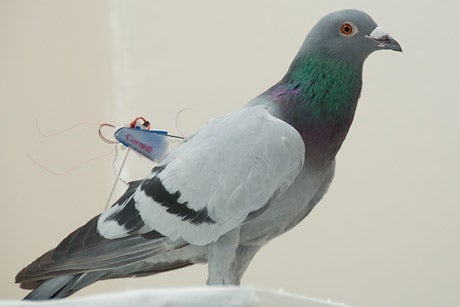
La página que intenta visitar sólo está disponible en inglés. ¡Disculpa!
The page you are about to visit is currently only available in English. Sorry!


(Photo by Michael Shafer via the Cornell Chronicle)
Birds will soon be donning a new fashion trend as they set off on migration. Researchers have been suiting up birds with tiny backpacks for years—tracking their movements across oceans and continents with solar-powered transmitters. But these latest backpacks will be looking to a new source for their energy: the birds themselves.
The trick is designing an energy source for the backpacks that is light enough for birds to tote. “You can’t put a 9-volt battery on a bird, so you need a lightweight energy source,” Michael Shafer, a doctoral candidate in Cornell’s Laboratory for Intelligent Machine Systems, told the Cornell Chronicle. To that end, the lab is building a device that will be powered by the birds’ own motion.
So far, Shafer is testing the backpacks on pigeons, which can only carry about 0.4 ounces—a little more than a dollar coin. Any more weight and the pigeons can’t right themselves after twisting or rolling midflight.
The removable backpacks are equipped with a tiny computer and memory storage, an accelerometer (to measure the birds’ acceleration), a wireless receiver, and, finally, the gadget that will convert the energy produced by the birds’ motion into electricity.
The backpacks will give ornithologists an alternative to the solar-powered trackers they currently use—helpful during the daytime, not so much after sunset. The new energy source can power the tracking sensors for longer, since it doesn’t depend on sunlight. Researchers can then chart the birds’ flight to learn more about how their migratory patterns are affected by climate change.
The backpacks—or, as the lab calls them, “Lab on a Bird”—are being funded by the NSF. No word yet on whether they will come in any fashionable designs.
Related Stories:
By Scott Weidensaul
9 Awesome Facts About Bird Migration
By Jhaneel Lockhart
Hurricane Sandy and the Storm's Effects on Bird Migration
By Kenn Kaufman